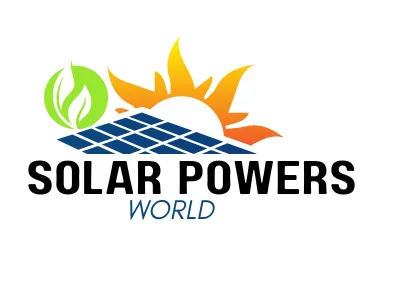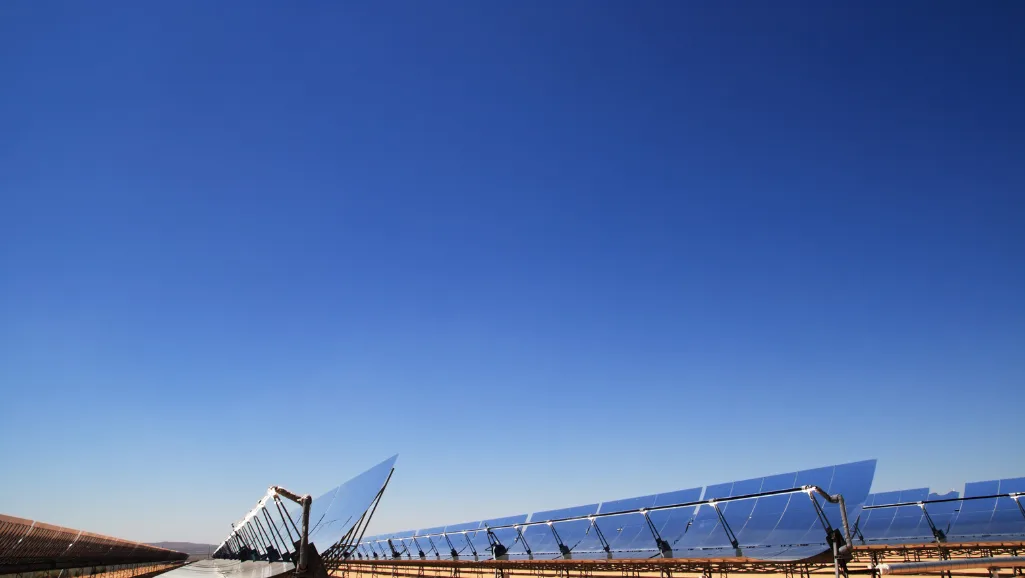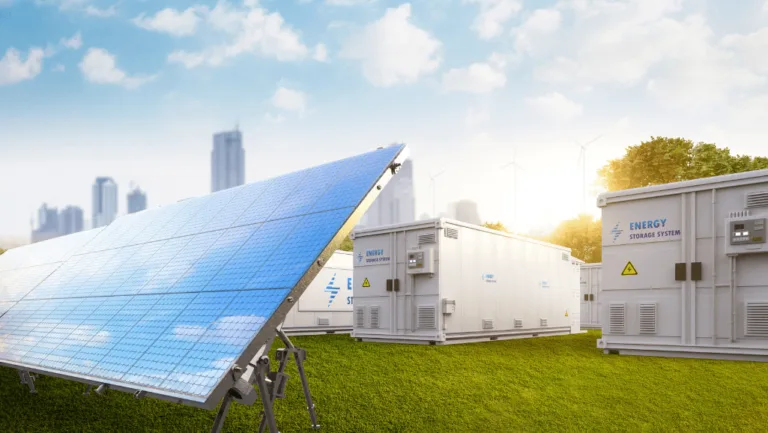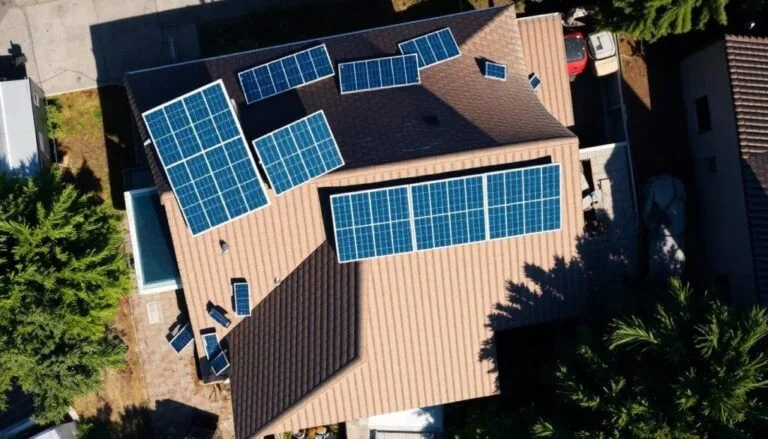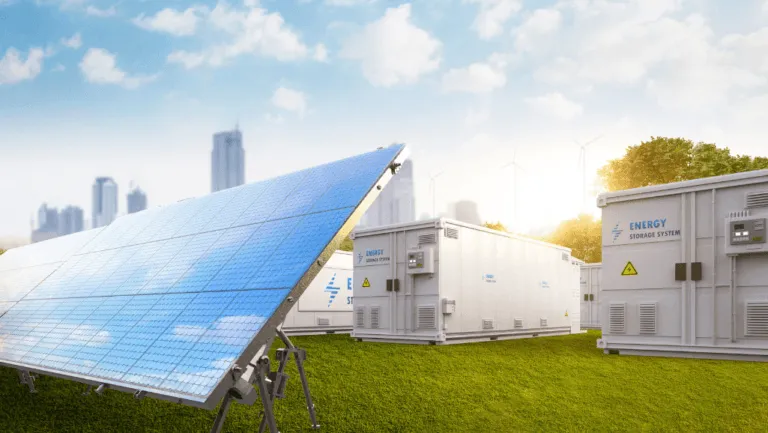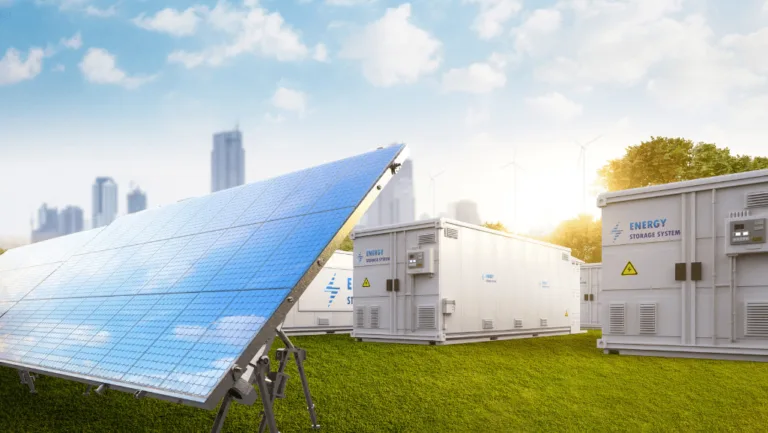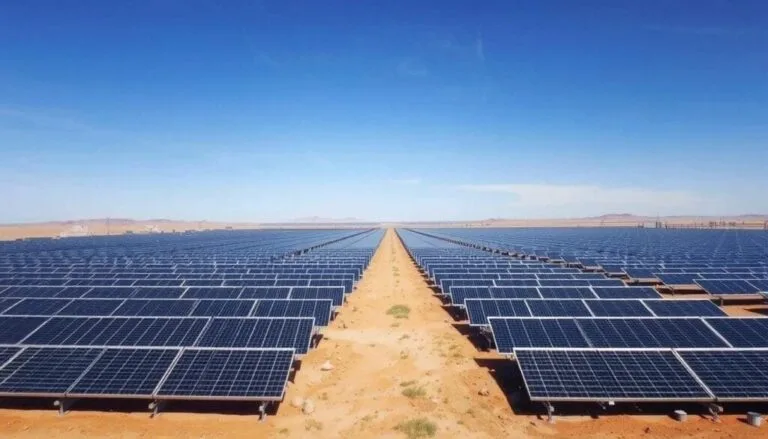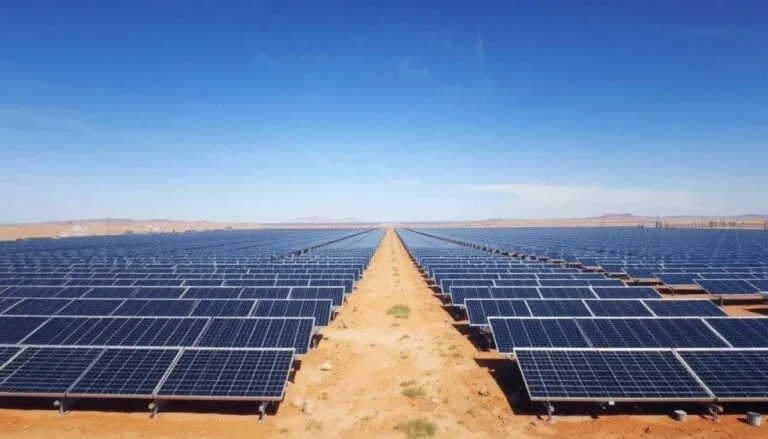The quest for clean, sustainable energy has led us to use the sun’s power. In just an hour and a half, the sun’s radiation could give us all the energy we need for a year. This fact has driven the creation of technologies that turn solar energy into electricity. This process is key to using renewable energy worldwide.
Photovoltaic (PV) systems are at the heart of this change. They turn sunlight into electrical power. These systems are becoming more common, from rooftops to large solar farms. Knowing how solar energy turns into electricity is important for our energy future and the planet.
Efficiency and flexibility are crucial in solar power generation. The sun’s energy varies greatly around the world, affecting how PV cells work. Photovoltaic systems are vital for the solar industry and our renewable energy future.
Technology is making solar energy more reliable despite its unpredictable nature. The goal is to make solar power a steady part of our daily energy use. Scientists and engineers are working hard to make this happen.
Key Takeaways
- how does solar energy create electricity.
- Solar panel technology harnesses solar radiation, offering a vast, untapped potential to meet global energy demand.
- Photovoltaic systems play a vital role in solar power electricity generation, with an operational lifespan that can exceed 25 years.
- The photovoltaic effect, discovered in the 19th century, is the fundamental principle behind solar electricity.
- While the efficiency of solar panels can vary, solar energy can still be collected during cloudy days, albeit at reduced rates.
- Leading the charge in solar power electricity generation, countries like China and the United States pave the way for others to follow suit.
- Solar farms illustrate the scalability of solar energy, capable of producing significant electricity to power communities and cities.
- Innovations in inverter technology and net metering contribute immensely to the practical integration of solar power into the energy grid.
Understanding Solar Radiation and Its Potential
The heart of solar energy conversion is knowing solar radiation basics. Solar radiation is the main force behind renewable energy electrical generation. It powers technologies that use the sun’s energy. From turning sunlight into electricity to using the sun’s power in big ways, understanding solar radiation is crucial.
The Infinite Power of Sunlight
Solar radiation is the light from our sun and is a vast energy source. Every second, the sun makes about 620 million metric tons of hydrogen into energy in its core. This energy is always there, ready to be used for power, if we can capture and change it through the solar energy conversion process.
Variability of Solar Radiation Across the Globe
Solar radiation hits every part of Earth, but its strength changes a lot. For example, Denver, Colorado gets almost three times more solar energy in June than in December. This change is important for planning solar energy systems.
| Location | June Solar Radiation (kWh/m2) | December Solar Radiation (kWh/m2) |
|---|---|---|
| Denver, Colorado | 7.5 | 2.5 |
Maps of solar resources help show these changes. They help place solar setups where the sun shines the most. This way, solar power stations in sunny places like the Southwestern United States can work better. Or, solar cookers can use the sun’s power everywhere.
The Science Behind Photovoltaic Systems
The core of photovoltaic system energy conversion lies in the sun’s power. This power is harnessed through advanced tech. The process starts when sunlight hits PV cells, made from materials like silicon. Silicon is key because it’s affordable and works well.
Since 1954, solar technology has grown a lot. Silicon PV cells are now a big part of solar power, used in homes and businesses around the world. New research is also looking into thin-film and III-V solar cells. These new types aim to make solar power better and more useful.
New solar tech brings new materials and ideas. For example, cadmium telluride is light but powerful. III-V solar cells are also being explored for their high power and efficiency. They’re used in satellites and space tech because they’re so efficient.
| Type of Solar Cell | Material Used | Common Applications | Efficiency |
|---|---|---|---|
| Silicon PV Cells | Silicon | Residential and commercial solar systems | Up to 30% |
| Thin-film Solar Cells | Cadmium Telluride, Copper Indium Gallium Diselenide | Portable calculators, advanced building facades | Less than 30% |
| III-V Solar Cells | Group III-V semiconductors | Space applications, high-cost solar arrays | Up to 47% (under directed light) |
PV cells 101 shows us that solar power works best when it’s part of a bigger energy system. This includes CSP plants and better grid tech. CSP uses mirrors to focus sunlight, making steam for power generation.
For a full picture of solar power, check out the U.S. Energy Information Administration. They have lots of data on solar energy and its effects on the energy grid.
The path from sunlight to electricity is both complex and exciting. It involves many technologies and scientific ideas. Ongoing research in solar tech aims for better systems. This could lead to a more sustainable and strong energy future.
How Does Solar Energy Create Electricity?
Exploring how solar power generation technology turns sunlight into electric power starts with understanding photovoltaic (PV) systems. These systems use the sun’s energy to do something amazing: change sunlight into energy.
From Sunlight to Electrical Charges: The Role of PV Cells
Solar panels have PV cells, made mostly of silicon. This material is great for its special properties. When sunlight hits these cells, it makes electrons move. This movement creates electric current, a process called the photovoltaic effect.
The type and design of PV cells affect how well they work and their cost. Most cells are silicon, split into monocrystalline and polycrystalline types. Monocrystalline cells work better but cost more. Polycrystalline cells are cheaper but not as efficient.
Converting Solar Activity into Usable Electric Current
Turning sunlight into electricity isn’t just about making a charge. This direct current (DC) isn’t what most devices use. That’s where the solar inverter comes in. It changes the DC into alternating current (AC), making the electricity ready for homes and businesses.
The way solar cells make electricity can be affected by temperature. High temperatures can lower efficiency. This shows how important it is to manage solar power well.
Looking into the efficiency of solar technologies, we see new materials and designs that help turn sunlight into energy better.
| Type | Material | Efficiency |
|---|---|---|
| Monocrystalline | Single Silicon Crystal | High |
| Polycrystalline | Silicon Fragments | Medium |
Learning about these basics helps us see the value of solar power generation technology. It shows how we can use nature’s power for a better future.
The Role of Concentrating Solar-Thermal Power (CSP)
CSP systems use mirrors to focus sunlight into receivers, turning it into thermal energy. This energy can power turbines or be stored for later use. This makes CSP a reliable source of electricity, thanks to advanced thermal storage.
In the last decade, the cost of solar thermal energy has dropped by over 50%. The U.S. Department of Energy aims to lower costs even more. They want to make CSP as cheap as $0.05 per kilowatt-hour with 12 hours of storage.
Most CSP plants use parabolic trough systems. These systems heat fluids up to 600ºC, making steam for electricity. Other technologies like linear Fresnel and parabolic dish systems also help in converting solar energy into thermal energy.
| Technology Type | Temperature Range | Typical Use |
|---|---|---|
| Parabolic Trough | 293ºC to 393ºC | Electricity Generation |
| Power Tower | Up to 600ºC | Steam Production |
| Linear Fresnel | Variable | Energy Generation and Storage |
| Parabolic Dish | Operates at High Temperatures | Power Conversion using Stirling/Brayton Engines |
CSP is key in the push for sustainable energy. It offers efficient solar thermal energy with great storage options. Research and funding are boosting its development, from collectors to power systems.
Projects like the NOOR I, II, and III in Morocco show CSP’s big impact. They highlight CSP’s role in modern energy, proving its sustainability and effectiveness.
Integrating Solar Power into the Electrical Grid
Adding solar systems to the electrical grid is key to using more renewable energy. As we use more solar power, we need better ways to connect it to the grid. This requires new tech and careful planning to keep the energy flowing smoothly.
The Challenges of Solar Energy Systems Integration
Adding solar power to the grid is tricky. The sun gives us a lot of energy, but it’s not always steady. We need smart solutions to handle this. Solar inverters and grid services are crucial because they turn solar power into what we use at home or in businesses. They also help manage energy sent back to the grid from solar panels.
Keeping the grid stable is hard, especially with solar power. Grid-forming inverters help keep the grid running and can even start it up during outages. This makes the grid more reliable. Managing energy from solar panels and traditional sources is complex, especially during extreme weather.
Advancements in Distributed Energy Resources and Microgrids
New tech is making it easier to use solar power. Distributed energy resources and microgrids help manage solar power’s ups and downs. For example, advanced batteries store extra solar energy. This helps keep the power steady, even when the sun isn’t shining.
Microgrids are groups of power sources and loads that can work on their own. They make energy more reliable and use local solar power better. This is good for the environment and can save money on energy bills.
Integrating solar energy into the grid is tough, but new tech is helping. Improvements in solar inverters and grid services are key. They help cut down on pollution and save money on energy, making solar power more popular worldwide.
Soft Costs: The Unseen Factors in Solar Energy Deployment
Many people focus on the upfront costs of solar energy systems. But, the solar energy soft costs basics are often overlooked. These include things like permits, loans, and getting customers on board. They play a big role in how affordable solar installations are, especially for homes.
Understanding solar technology cost analysis is key to managing these soft costs. Projects backed by the U.S. Department of Energy show how solar costs change. They focus on cutting costs that don’t involve the physical parts of the system.
The importance of workforce development is huge in lowering costs. Training a skilled solar workforce means installations and upkeep go smoothly. This reduces mistakes and delays. Programs by Easan Drury at NREL highlight how not knowing about solar can stop people from adopting it. So, better training and teaching communities about solar is vital.
Training isn’t just about tech skills. Projects by Kiran Lakkaraju at Sandia National Laboratories and Varun Rai from The University of Texas at Austin look at social and economic incentives. They aim to make solar PV more popular at home. These efforts are key for training a workforce that gets consumer needs and market trends.
New solar technologies like transparent solar panels need solar workforce development to fit into cities and boost energy output. As these techs move from idea to product, the workforce must keep learning about the latest in the industry.
In short, cutting solar energy soft costs is possible with smart analysis and improving the workforce. As experts and researchers keep working on these areas, solar tech will get cheaper and more accessible for more people.
Exploring the Economic and Environmental Benefits of Going Solar
Switching to solar energy helps us move towards green energy. It brings big economic and environmental wins. Key benefits include reducing electricity costs with solar energy, making the resilient electrical grid stronger, and boosting solar industry job growth.
Reducing Electricity Bills and Ensuring Resiliency
Going solar means big savings on electricity bills for homes and businesses. The average U.S. household uses about 10,632 kWh a year. Solar power cuts down these costs and lessens our reliance on traditional power grids.
This change leads to lower bills and a more resilient electrical grid. This grid can handle various challenges, like natural and human-made problems.
Job Creation and the Growth of the Solar Industry
The solar industry is growing fast, creating more jobs. As we use more renewable energy, we need more skilled workers. Jobs in solar include installation, maintenance, and tech updates.
This growth boosts the economy and supports sustainability.
| Statistic | Impact |
|---|---|
| Installation of solar systems | Equivalent to removing the emissions from 19,316 miles driven by an average car annually |
| Average Electricity Consumption Reduction | Can lead to savings similar to planting 125 trees annually |
| Solar Panel Efficiency Increase | 33% increase over the past decade |
| EPBT Drop since 1996 | Declined by 12.8% |
Rooftop solar panels are more than just a financial win. They’re key in cutting down greenhouse gas emissions. Choosing solar energy means using less non-renewable resources and helping our planet. It’s a smart move for a sustainable future.
The Technology Advancements in Solar Power Generation
The solar power industry is changing fast thanks to solar photovoltaic technology advances and new solar energy research developments. These changes aim to make solar power more competitive. The latest in panel efficiency and energy storage are setting new standards.
Innovations in Solar Panel Efficiency and Storage Solutions
Solar panels now convert over 25% of sunlight into energy, a big jump. For example, LONGi set a record with a 26.81% efficient solar cell in November 2023. Now, energy storage solutions like lithium-ion and flow batteries are improving. They increase energy density and make solar energy more useful.
Emerging Trends in Solar Power Generation Technology
New trends like bifacial solar panels and ultralight fabric solar cells are changing solar energy’s future. Bifacial panels catch sunlight from both sides, boosting energy production. Meanwhile, MIT’s fabric solar cells are light and versatile, opening up new markets for solar power.
Over the last decade, solar panel technology has cut costs by up to 90%. This makes solar power more accessible and useful. Companies like Adani Green and Lightsource BP are leading the way with big solar projects.
| Company | Location | Capacity | Project |
|---|---|---|---|
| Adani Green Energy | Gujarat, India | 1 GW | Khavda Solar PV Park |
| Lightsource BP | Greece | 560 MW | Solar PV Park |
Research and development in solar technology are creating a brighter, cleaner future. Solar energy is becoming a top choice for renewable energy, leaving traditional fuels behind.
With cost cuts, efficiency boosts, and new uses, solar power is set to meet more of our energy needs. This is thanks to tech progress and growing awareness of the environment. For more on the financial and environmental benefits of solar power, check out solar energy’s challenges and benefits.
Conclusion
Solar energy is key to a cleaner future. Its growth shows our creativity and care for the planet. Households save up to £1,190 a year on energy bills with solar panels. In the UK, homes with solar systems sell 20% faster, showing the demand for energy efficiency.
Technological advances in solar energy are impressive. From Edmond Becquerel’s discovery in 1839 to today’s Silicon-based panels, progress is clear. Solar energy doesn’t emit greenhouse gases or air pollutants, helping fight climate change and improve air quality.
Now, solar batteries let homeowners store extra power for later. Policies like the Smart Export Guarantee support solar energy users. With 173,000 terawatts of solar energy available every hour, solar power can meet our electricity needs fully. We’re moving toward a future powered by the sun, making energy renewable and abundant. This shift will create a greener, healthier world for all.

